|
BULB LOG 44 --- 29th October 08

Sunny Bulb house 22.10.08
As I write it is a very cold frosty 28th October with a sprinkling of snow lying. I can look back to a photograph that I took last week when the sun shone and the bulb house warmed enough to encourage all the crocus to open their flowers - it is not just light they need to open but also a certain degree of warmth.
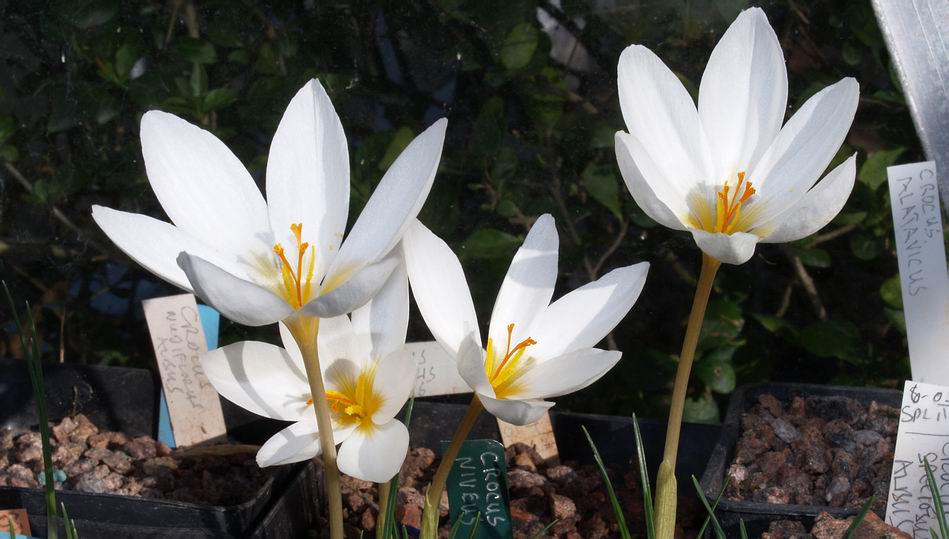
Crocus niveus
For us Crocus niveus is among the later of the autumn flowering species with its flowers just opening this last week. I have seen quite a lot of Crocus niveus sold in the trade that is wrongly named - it turns out to be Crocus hadriaticus. I suspect that it comes form a single source and that it has been misnamed for a very long time. I first bought some corms of C. niveus 15 or 20 years ago from a very well known bulb specialist and they were also C hadriaticus. Not that I was disappointed because in many ways I prefer C. hadriaticus with its well scented flowers over C. niveus.
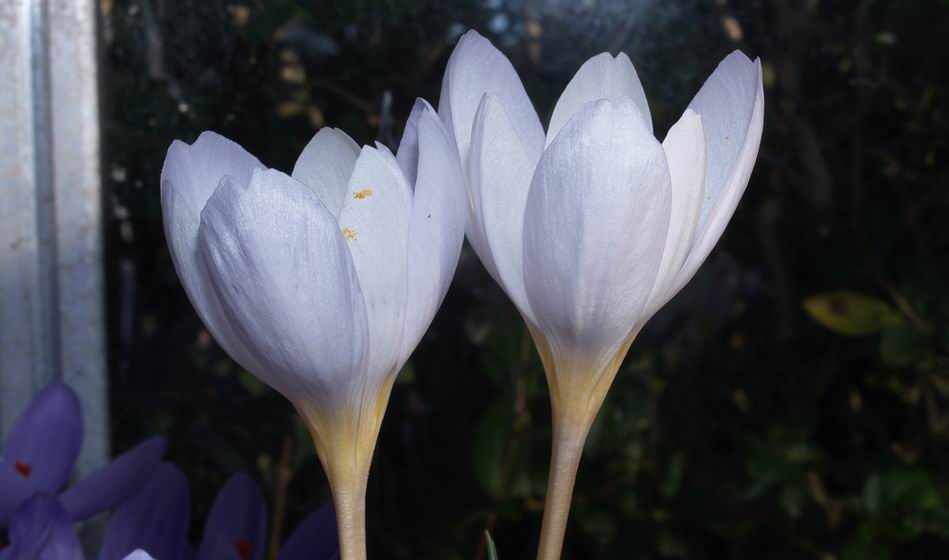
Crocus niveus violet flush
Crocus niveus as the name suggests is predominantly white but I got this form which has a violet flush from Tony Goode, so there is variation to be found.

Crocus laevigatus
The first of our Crocus laevigatus are now in flower - this species cannot decide if it is an autumn or a spring flowering crocus. Perhaps we should call it a winter flowering species because we will have various forms in flower from now until February so it really does bridge the gap between the autumn and spring.
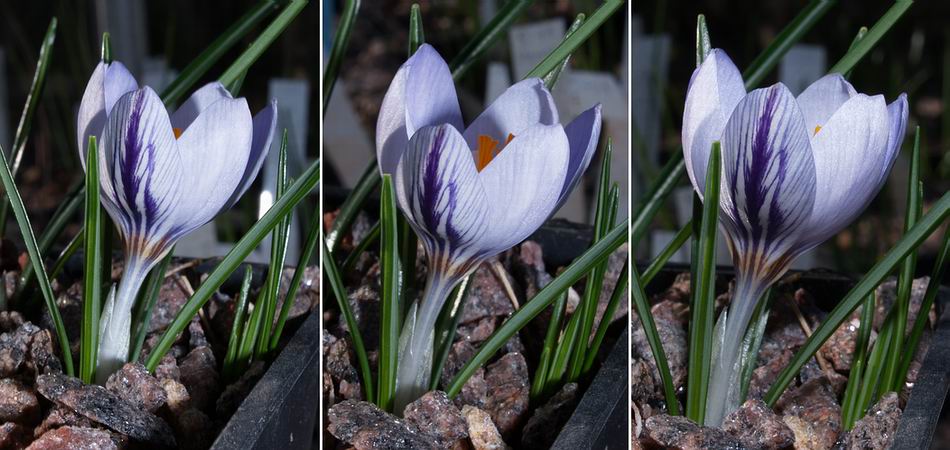
Crocus laevigatus x3
Here are three views of the same Crocus laevigatus and when taking its picture I was struck, not for the first time, how nice it would be just to have a single crocus in a 7cm pot so you could enjoy the beauty of the individual instead of the mass display we see from a pot full of flowering corms. However nice or desirable that would be I do not have enough space to indulge in that level of presentation and on the Show benches the Judges would quickly pass over a single crocus in a pot but sometimes less is more.
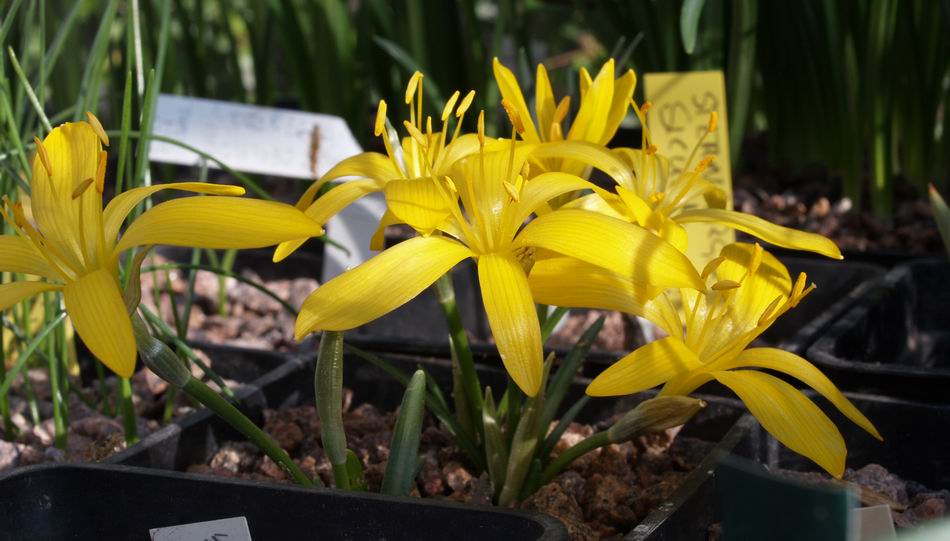
Short stem Sternbergia sicula - Sprunt
One of the good things about taking photographs is it lets you look backwards through time to what flowered days, weeks or even years ago and I have been waiting for my Sternbergia sicula forms to flower so I can show a number in a single log. There has been much interesting discussion and a host of wonderful pictures of this species on the forum pages and everyone seems to come to the same conclusion - utter confusion. This is a very good short stemmed, free flowering form that I got from Glassford Sprunt - often producing several flowers per bulb.

More forms of Sternbergia sicula
Here it is on the left with another form on the right Sternbergia sicula #2 which has longer stems with smaller flowers and while it does flower well it is not nearly so floriferous for us as the one from Galssford.
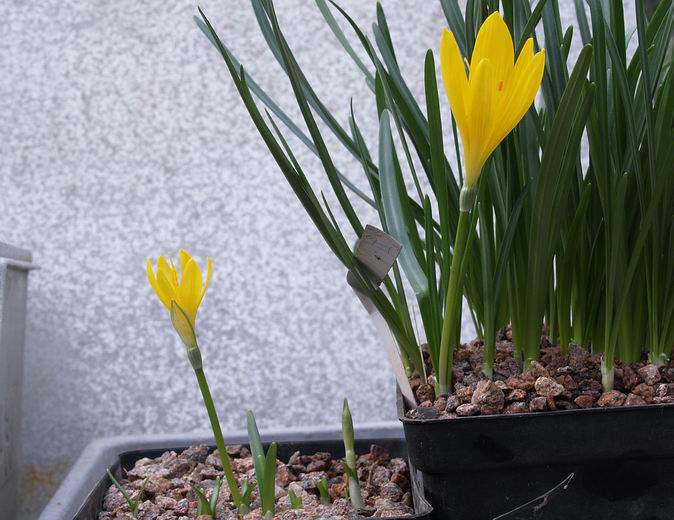
Compare two forms of Sternbergia sicula
Now we move up again with Sternbergia sicula #2 on the left and another again larger form on the right. This form on the right is the most commonly seen one and is getting close to the same size as Sternbergia lutea.
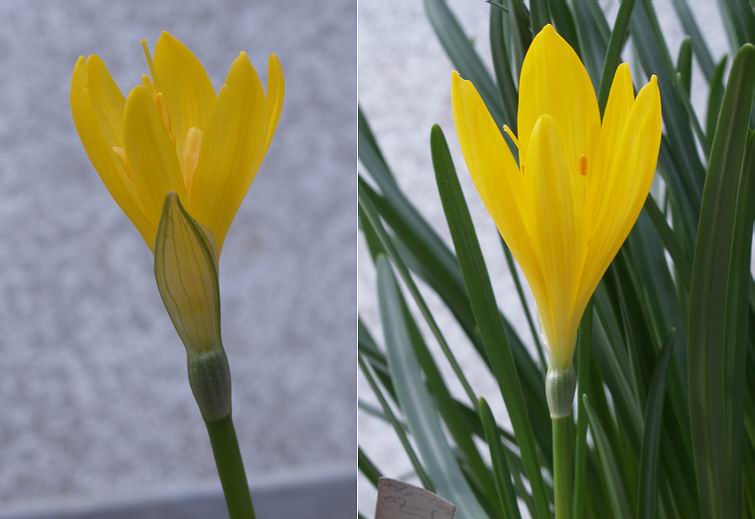
Sternbergia sicula x2
Here are close-ups of the flowers from the previous picture. The flowers do have acute tips as opposed to the rounded tips described for S. lutea but the leaves of the right hand one exceed the described width for S. sicula which is up to 5mm but at 6mm wide they are narrower than the 7-12mm width described for S. lutea ! The one common feature that all the forms of S. sicula that I have share is that they all have a silver stripe running up the centre of the leaf. Martin Rix describes it as Sternbergia lutea ssp sicula so these forms cause confusion everywhere.

Second flowering Sternbergia sicula - Sprunt
A week after the first flush of flowers on the form I got from Glassford have faded, another bunch appear making it number one among my choices for flower power under cold glass in North East Scotland.

Sternbergia sicula buds - Leeds
And then we come to this wee beauty that I got from Rod and Jane Leeds with its very narrow almost prostrate leaves and these enormous flowers that sit so close to the ground.
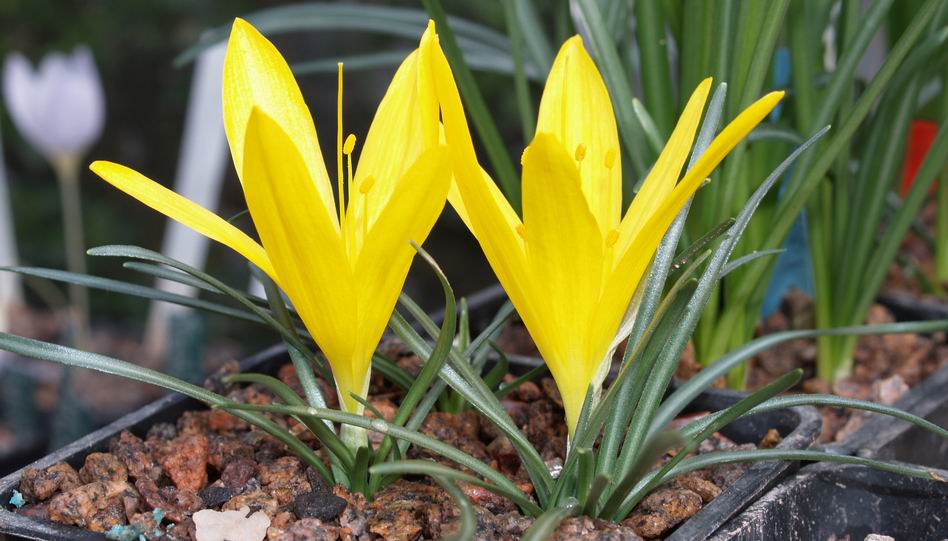
Sternbergia sicula - Leeds
As the flowers open you can see the full beauty of these flowers with their acute tips, long style and pollen laden anthers. Other keys for Sternbergia mention the length of the filaments but as it gives an overlap in the lengths between sicula and lutea it only adds to my confusion. The conclusion that I have drawn from all my looking at these plants is that S. sicula is a muddled species to say the least but as it is also a very beautiful one I will continue to search for good forms that will flower well in the colder north.
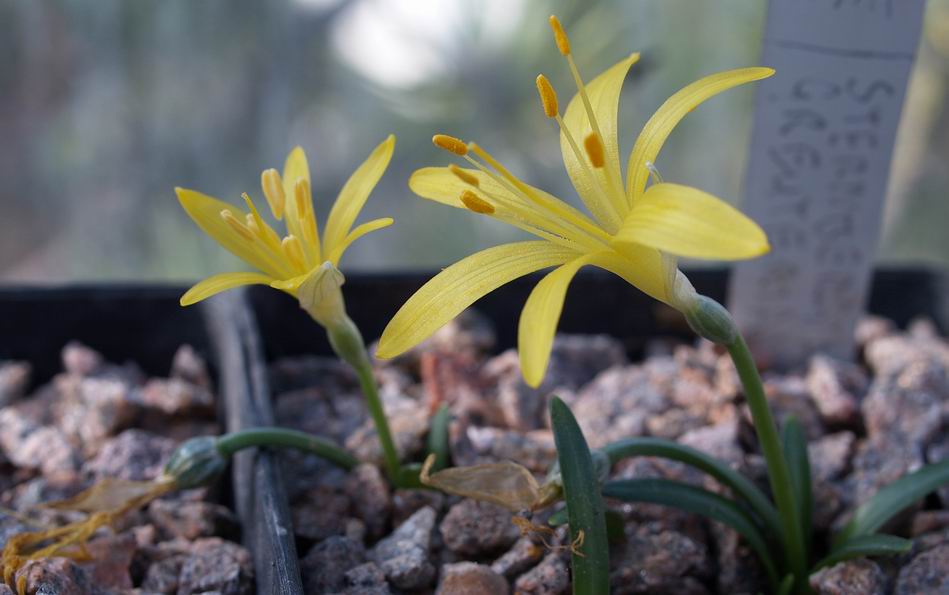
Sternbergia greuteriana
As I can see many possibilities that the forms of S. sicula may well be hybridised with S. lutea, I do not think that we can rule out this wee beauty, Sternbergia greuteriana, from the mix. However the form that I show above is very distinct - I first showed it a number weeks ago and now it is on its second flush of flowers. You can see the seed pods from the first flowers bending down towards the gravel - a characteristic of this plant.
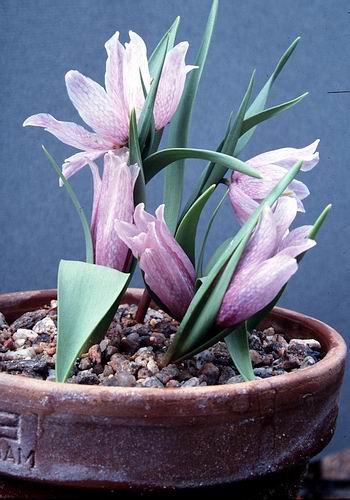
Scanned slide of Fritillaria alburyana
No, this is not in flower just now but as I mentioned above the good thing about photographs is that you can keep a record of flowers and gardens from years ago. When I switched to digital for both photography and my talks about 7years ago my slide collection almost became redundant as I could not find a method to copy the slides to a digital format that I could afford and that would not take a very long time to do.
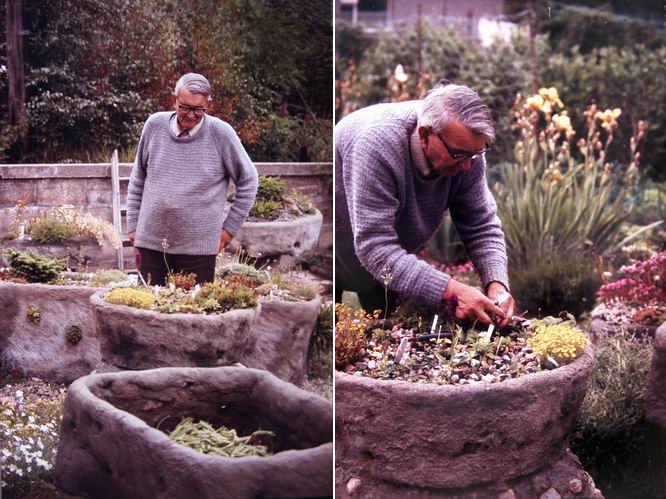
Alec Duguid
I have tried many slide scanners with varying results over the years few of which I would be happy to use in presentations. Recently I borrowed a couple of slides showing the late Alec Duguid, formerly of Edrom Nurseries, from Jim Sutherland and I needed to copy them and return them. I decided to try simply photographing them using my digital SLR and macro lens. I taped the slides to a window, got Maggi to go outside and hold a sheet of white paper about 20cms from the window to give me a white light source and lo and behold I got the most satisfactory digital copies of slides that I have had to date.
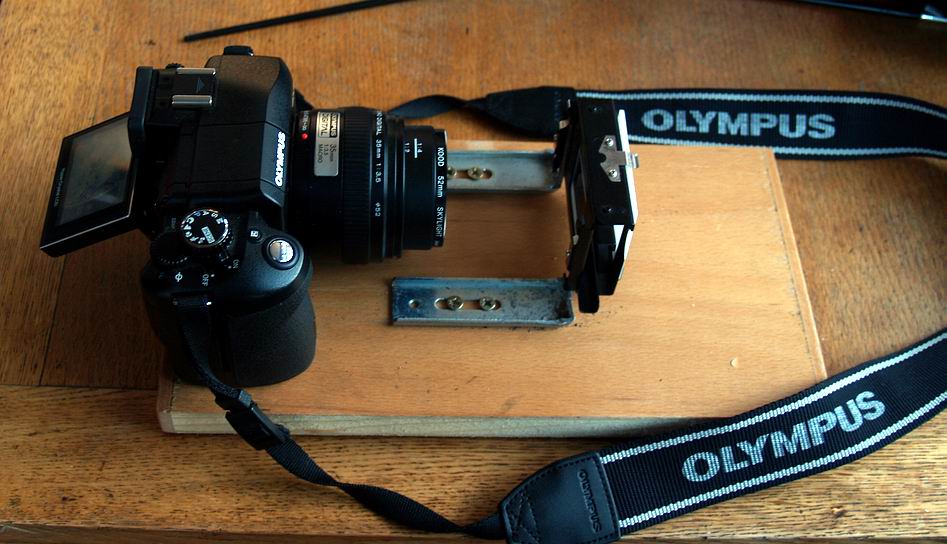
Digital slide copier
This got me thinking - I rummaged about in my box of old SLR cameras and lenses to find my old slide copier and removed the slide carrier - I made two metal brackets that would hold it in place but also allow me a small degree of adjustment both up and down and back and forward and screwed them to a piece of wood.
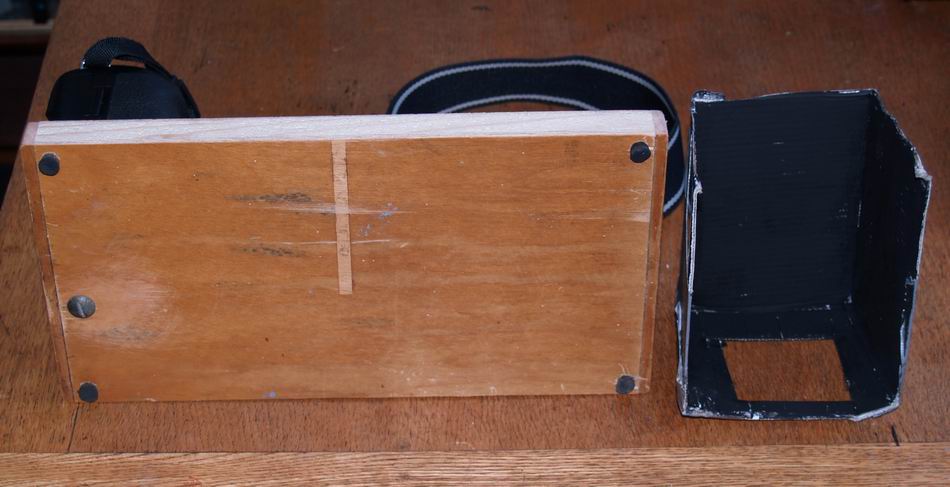
Base of slide copier
I drilled a hole for a screw that was the same thread as the tripod socket on the camera so that the camera was held rigid at the correct distance for the macro lens to fill the frame and added four rubber pads to allow the board to sit steady on a table top. The final refinement was to make a hood to black out the light between the camera and the lens - this was just made from a small cardboard box painted mat black inside with a slide shaped aperture at one end.

Copying slides
Here we have my new 'high tech' slide copier! My Olympus E330 has a very convenient flip out LCD screen that gives me a live view of the subject and this makes the whole process very quick and simple to use. I stick a slide in the carrier, place the blackout box over the lens and push the shutter allowing the auto-system on the camera to focus and set the exposure.

Scanned slide of Lilum nanum
Now I can get scans of all my old slides that I am perfectly happy to use in presentations and I can even zoom in and enlarge only a portion of the original slide with acceptable quality. Speed wise I can easily copy 50 slides in about ten minutes and the only adjustment I have to make in the computer is to crop the image slightly to suit the digital format - of course I also have all the other digital manipulation tools to use if required. My slide collection has suddenly come alive again and I can look back beyond 2001 when I went digital.
^ back to the top ^
|

